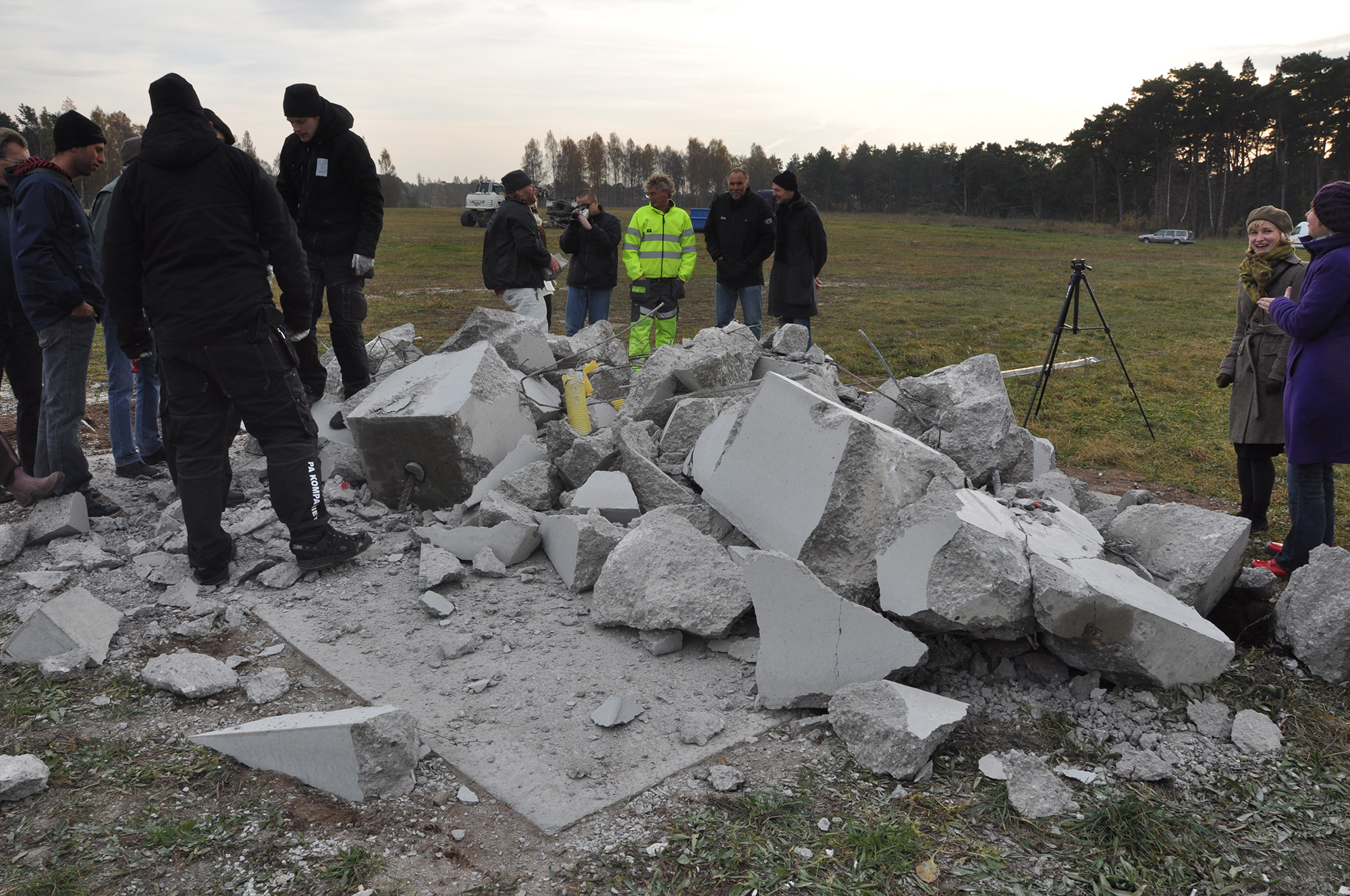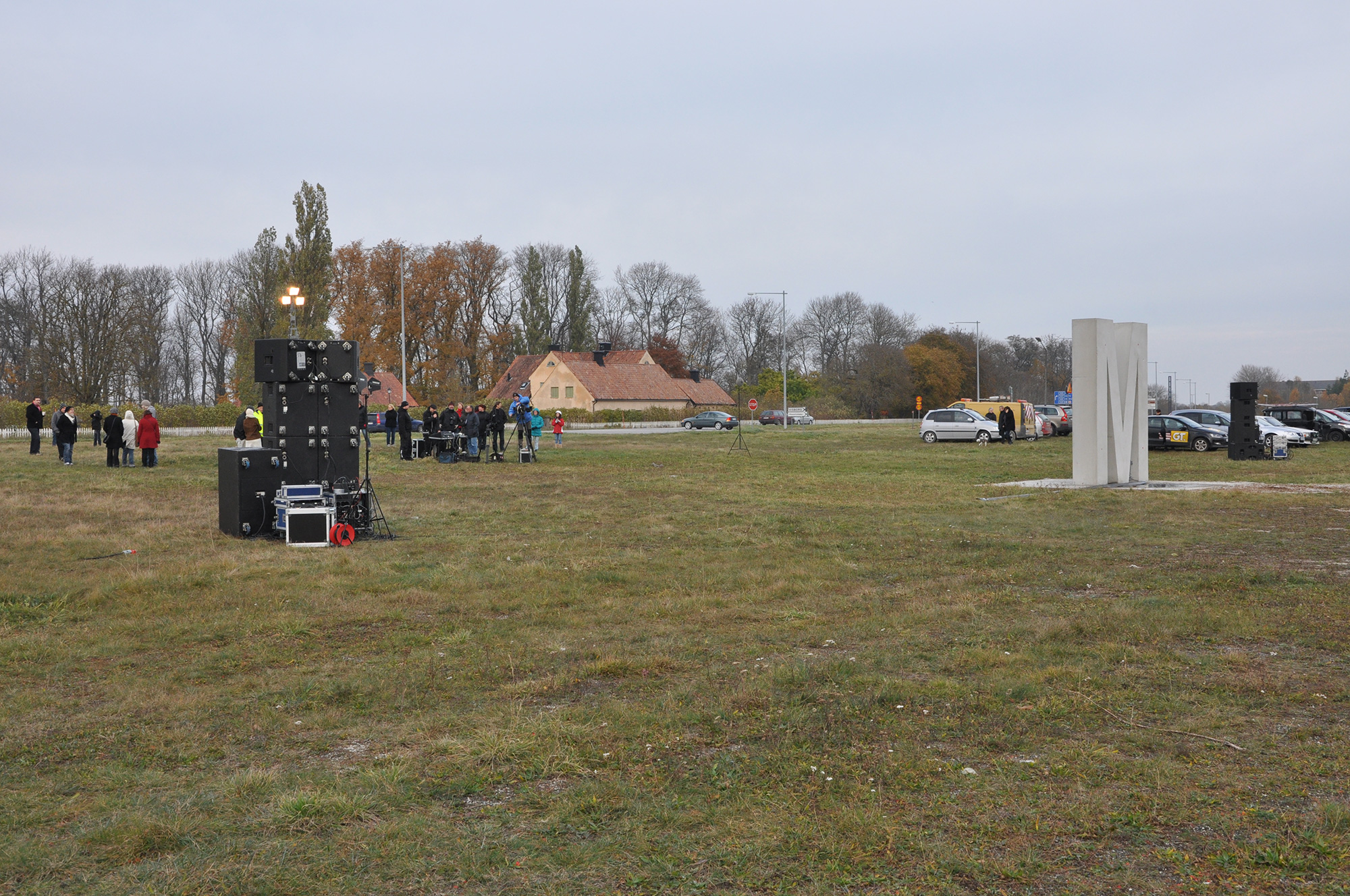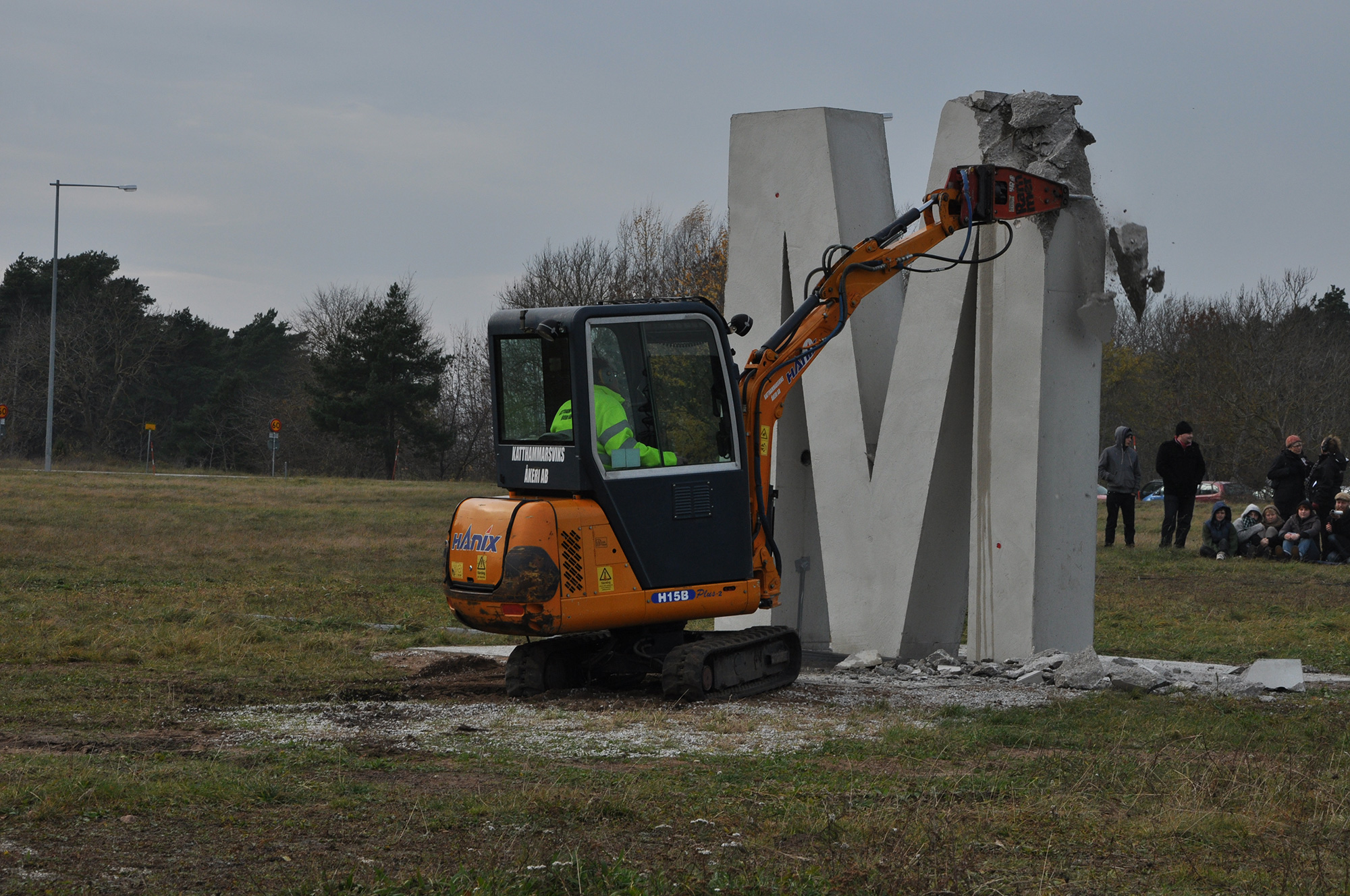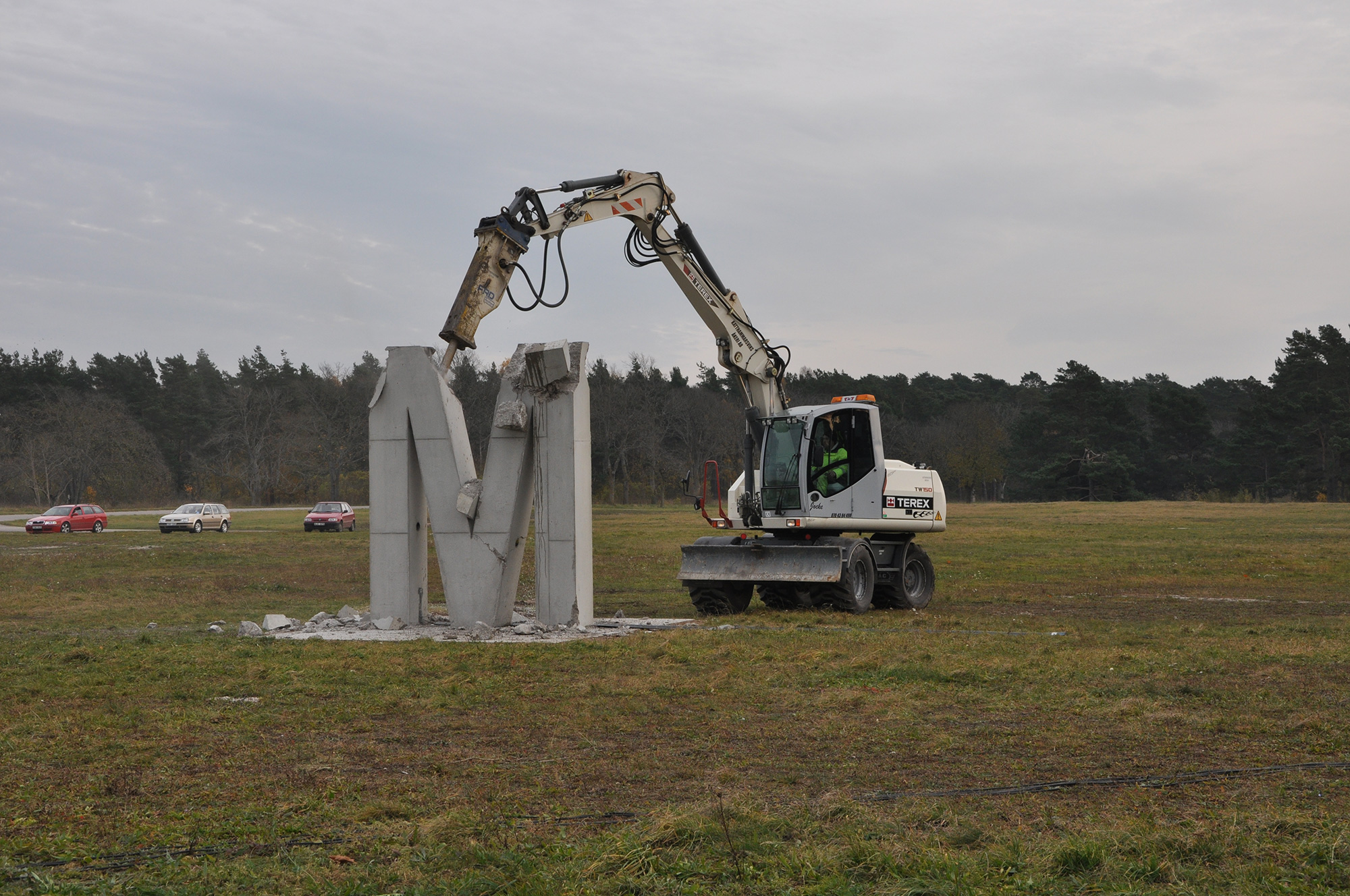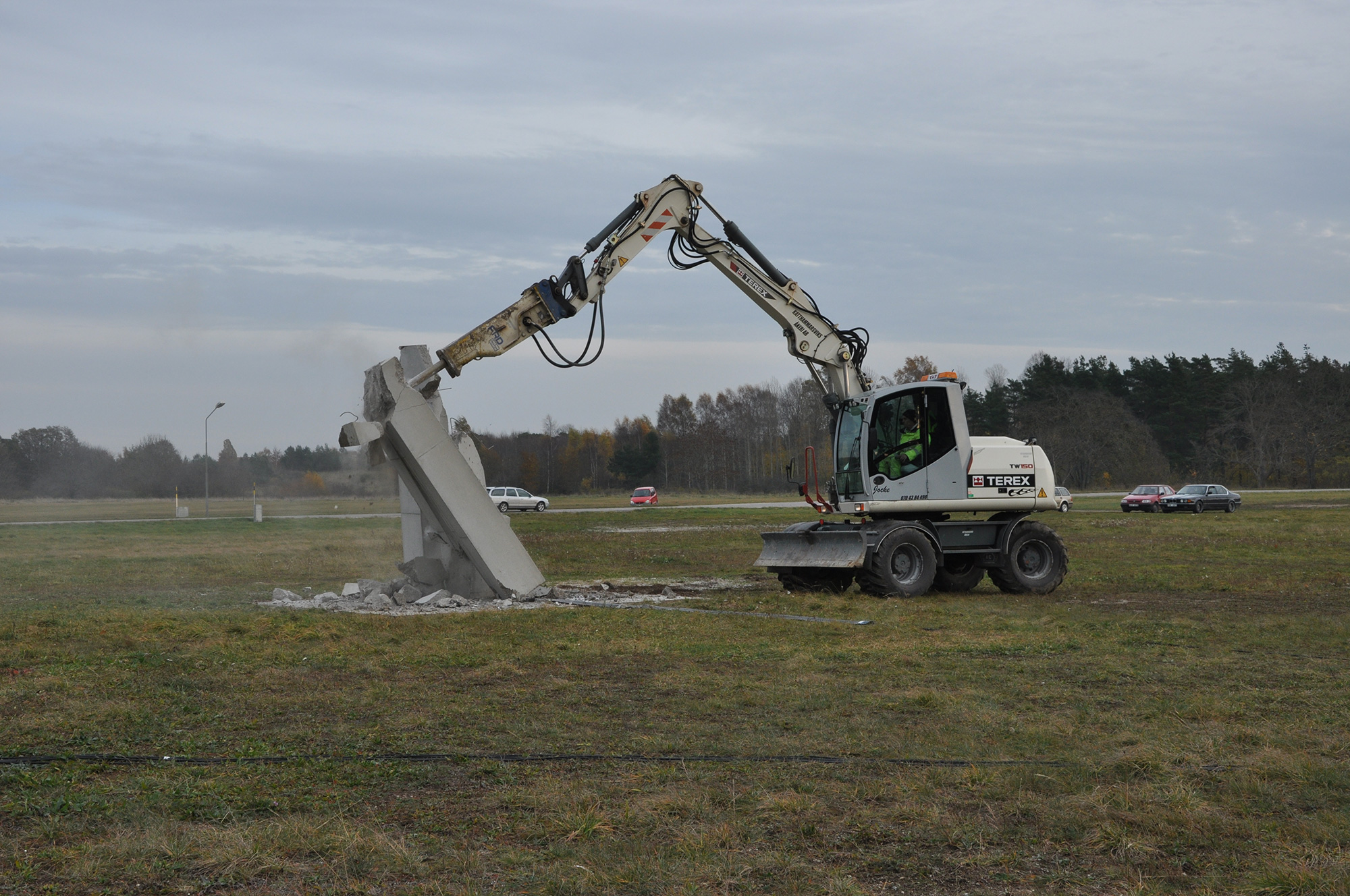BAC 20th Anniversary
- •
- •
- •
- •
- •
- •
Santiago Sierra, "Destruerat Ord: Olika platser oktober 2010 - oktober 2012". Med tillstånd från konstnären.
Two Years: The Dematerialisation of the Art Institution,
BAC’s 20th year celebration is coming to an end – we’re eagerly looking forward to turning 21! We’re closing our jubilee with a last visit to the history of BAC and the archives together with Lisa Rosendahl, who held the position as director 2008-2010. When she took office, it had recently been decided to close the exhibition space of BAC. BAC would nevertheless continue to commit itself to the production of new artistic works through formats like the Production-in-Residence programme. For the new director, this direction provided an opportunity to reformulate the mission of the art institution.
During her two years at BAC, Lisa Rosendahl would launch a number of projects and residency programmes together with artists, theorists and curators, that challenged the conventional ways of producing, presenting and disseminating art. One example is the global art performance Destroyed Word by Santiago Sierra produced as part of the Destruction-in-Residence project at BAC and presented in Visby in 2010. The live action event in Visby was the first part of this new work Sierra and involved the destruction of a 3.6 meters tall, concrete letter (M) erected by the artist in a field just outside Visby city centre.
The artist’s use of concrete in Destroyed Word resonates particularly within the context of Gotland. Having contributed greatly to the economic development of Gotland, the cement industry has simultaneously made a major environmentally destructive mark on the island, leaving it perforated by the gaping holes of lime quarries, some now defunct and abandoned, others currently active. The project was then continued by Sierra with ten similar actions at different locations around the world, each offering the destruction of a new letter and gradually revealing the full meaning of the word – backwards for the sake of suspense.
Two Years: The Dematerialisation of the Art Institution
By Lisa Rosendahl
The following is an attempt to outline a process of institutional re-articulation that took place at the Baltic Art Center (BAC) in Visby between 2008 and 2010. The text focuses on my 2008 decision, as the newly appointed director, to use the specific circumstances of the institution as a starting point for revisiting a set of questions that have been of central importance since the early twentieth century avant-garde: How is art production defined in relation to the production processes of society at large? How do we understand the structures and organising principles of the art field in relation to the ways in which work and value production are organised generally? Which ideological constructs lie behind regulatory frameworks – such as notions of authorship and ownership, the division of labour between artists, curators, institutions and audiences and the definitions of and the relationship between process and product – and how do we, as professionals within the field, confirm and perpetuate them through our daily work? Could leaving these frameworks behind generate possibilities for defining artistic labour and its relationship to the production processes of late capitalist society differently, unleashing a transformative potential? If so, how do we do this? What kinds of support structures are needed to foster such processes of redefinition and change?
BAC, a publicly funded art centre, located on the Swedish island of Gotland in the Baltic Sea, a couple of hours from the mainland, was founded in 1999 as a consequence of governmental interest in supporting cultural dialogue between Sweden and the Baltic states in the wake of the fall of the Iron Curtain. Housed in a redeveloped grain storage building in the harbour of Visby, BAC quickly developed from being a provincial kunsthalle with a Baltic focus into a site for international art production. In 2005, its founding director, Johan Pousette, and the current board started a Production-in-Residence (PIR) programme in response to what was perceived as an increasing need for emerging international art practices to receive greater economic and organisational support. PIR was also a way of reinventing the traditional model of the international artist’s residency, by placing the production, rather than the artist, in the position of being ‘in-residence’. In concrete terms, this meant that an artist would not be expected to stay at BAC for a long period of time, but might instead undertake several shorter visits to the island at different stages of research and production, at the same time maintaining a dialogue with the institution throughout the process of developing the work. In addition to the residency programme, BAC ran an exhibition space in which many of the new productions – such as works by Rosa Barba, Annika von Hausswolff and William Kentridge – were shown for the first time before they entered the global art circuit.
In 2007, things changed; the BAC board had to restructure the organisation and a downsizing became necessary as some of the temporary funding ran out and was not replaced with any permanent solution. A decision was made to abandon the ‘state-of- the-art’ exhibition hall and terminate its regular public programme. In the process, BAC also lost its purpose-built studios and half of its staff. However, the board wanted the focus of the organisation to remain on the production of new work and resolved to retain the Production-in-Residence initiative.
Taking over as director the following year, I chose to interpret the continued commitment of the board to artists’ production processes, coupled with its decision to give up an exhibition space in which any possible outcomes could be displayed, as potentially radical. For me, the liberation of production processes from the demand for conventional gallery display signalled the possibility of redefining the ways in which the term ‘production’ could be used in relation to art and called for a focus on processes rather than products. Furthermore, what those processes might be or where they would take place was up for discussion. The decision by the board to abandon the original physical spaces of the institution became my operational and curatorial starting point, providing the impetus to explore which other frameworks and conventions could be removed from the modus operandi of BAC and to what effect.
Without the pressures of running a public exhibition programme, BAC now had the chance of developing projects according to other rhythms. Without an exhibition hall, the relationship between BAC and the public not only could be but had to be reinvented beyond the traditional exhibition-spectator dichotomy. The lack of permanent studios meant that suitable workspaces would have to be found for each project, not the other way around. The same applied to staffing and, with only a small team of core employees remaining, specific expertise would have to be called in as and when each project demanded. In short, BAC had become a hyper flexible institution that aimed to transform itself in relation to every art practice with which it engaged. What set it apart from other art organisations working out of an office on a project basis – such as Artangel in London or Mobile Art Production and Mossutställningar in Stockholm – was that BAC primarily devoted itself to the artistic process, with the issue of creating something for public display remaining a possibility but not a core aim. For me, it was of prime importance that the resources of BAC would not simply be used to produce new works that would be exported to another context as soon as they were finished, to be exhibited elsewhere, but that they would offer support to artistic practices working to interrogate the established frameworks determining the field. This brought forth some key questions: If each practice or project was allowed to shape the support structure it needed, in dialogue with the institution, and to set the parameters for its own coming into being, and if there were no predetermined institutional requirements to fulfil – in terms of space, timeframe, money or result – but nonetheless sizeable support in the form of funding, dialogue and project management, would it generate a climate in which the established conventions of the art industry could be left behind in favour of other modes of working with and through art? Would it even be possible to leave behind the idea of art and the artistic process as production?
In 2009, I started a number of projects together with artists, curators and theorists, with the intention of exposing and interfering with the existing systems for artistic production and/or dissemination. These projects were run in parallel with the existing PIR programme and other newly started initiatives, such as the Collaborative Research Residency (developed together with Fabrikken in Copenhagen and Hordaland Kunstsenter in Bergen), as a way of investigating the existing conditions of the institution and the ways in which they could be rethought. The Secret Cinema (note 1), Destruction-in-Residence (note 2) and On the Conditions of Production (note 3) all engaged in different ways with the dissolution of individual authorship and the division of labour in the art world, as well as with exploring ways of renegotiating the concepts of process and product and their relationship to each other. Often using strategies of anonymity, withdrawal, secrecy, erasure or deferral, the projects addressed the questions at hand from within artistic and curatorial practice, attempting to start each process without articulating any desired outcomes, letting each work find its form along the way.
To summarise what those working processes generated would be to miss the point, as the aim had been to move away from the measurable and conclusive, the easily packaged and circulated. However, what did become clear was that BAC, as an institution without framework, engaging in production without predetermined protocols, created a strong sense of ambivalence. It was, of course, to be expected that professional identities, including my own, were destabilised by this approach. But, in its aim to break down the standardising structures of artistic production and their underlying politics, the experimental reorganisation of BAC walked a tricky path. This process exposed a fine line between diverting from and collapsing straight into the arms of post-industrial capitalism. BAC’s commitment to the continuous innovation of labour processes without easily definable ends fits squarely within the logic of our times: the speculative financial market as well as the sphere of prosumer social media, to name but two areas of contemporary life that long ago moved to a point at which an end product was no longer necessary, becoming superseded by the production of relations. But what kind of relations are they? The idea at BAC, that the relationship between artist and institution would be reshaped anew for each project, through dialogue and joint decision-making, had its problems. The flexible, non-specialised, always-ready-to-react- to-any-unpredictable-situation institution mirrored the precarious subjectivity of the artist as post-Fordist worker par excellence, often creating a feedback loop of uncertainty and instability. At the same time, the traditional power relations between artist and institution – manifested, for example, in the act of remuneration or the position of responsibility in the face of the law or the funding bodies – were still there. Even more difficult to dispel were the unspoken expectations, hiding within each of us who took part and the persistent narratives that formed our subjectivities.
The experimental re-articulation of BAC during these two years was a first step towards rethinking the relationship, in that specific situation, between institutional support and artistic process, which did not, in itself, bring forth any sustainable working models. With hindsight, it is easy to see that the process of unravelling all the stable ground of an institution – albeit in an attempt to inject new life into an already emaciated situation – would, in the short term be more unsettling and full of contradictions than generative. As can be learned from Lucy Lippard’s book, Six Years: The Dematerialization of the Art Object – in which she summarises the development of Conceptual Art in the US between 1966 and 1972 – the attempted dissolution of the art object as a site of value production did not constitute an escape from the hegemonic order of value production itself. Yet, it opened up for new ways of understanding the challenge.
At a lecture in Stockholm in 2011, Zygmunt Baumann described our current times as a moment of interregnum, a historical passage in which the old systems are falling apart but new ones have yet to be conceptualised and enacted. For two years, between 2008 and 2010, BAC operated in a similar vein, undoing its own raison d’être and engaging in the task of unlearning. Although the implementation of new systems was most certainly deferred, the questions fuelling the changes were gradually refined to become: If the historical avant-gardes positioned themselves in relation to industrial society, how do we position ourselves in relation to the current, so called post-industrial, reality? How can we move beyond precarity, self-exploitation and the insecurity of endless flexibility without stagnating in the systems of the past? How do we shift from the necessarily backward-looking post– towards a more hopeful and anticipatory pre-?
How can we not only take control of the means of production and their organisation but also learn how to think beyond the concept of production itself? Can art be a means of finding those ways of being and working together? And, if so, what kinds of support structures will be needed to foster such processes of redefinition and change?
1. The Secret Cinema was a series of screenings and related discussions, in which the title, director and duration of the film would not be disclosed to anyone apart from those attending the event. Taking Peter Watkins’s notion of monoform as a starting point, the programme tried to create a framework in which the attention and engagement of those involved surpassed the attention economy, as well as the economy of copyright and distribution laws. The series was open to suggestions of films from anyone attending.
2. Destruction-in-Residence was a tool for looking at the concept of production from the point of view of its opposite. Artists and cultural producers were invited to engage with acts of destruction, removal and/or erasure – conceptually, structurally and physically – in relation to the context of BAC. The first intervention as part of the series consisted of the invited artist removing his/her name from all publicity connected with the project. The second part, Destroyed Word, involved Santiago Sierra’s physical act of destroying a concrete sculpture in public space.
3. On the Conditions of Production is a collective research project, run by Kajsa Dahlberg, Kim Einarsson, Mattin, Michele Masucci, Lisa Rosendahl and Fredrik Svensk, which investigates the conditions of various production situations in contemporary capitalism, as well as the condition of the art world as a whole. For further reference, see the collectively written text, A Living Body Performing Its Own Autopsy Within Contemporary Capitalism, pp.219–229 in this publication.
Published in Work, Work, Work: A Reader on Art and Labour published by Konstnärsnämnden/Iaspis and Sternberg Press in 2012.
is a freelance curator and writer based in Berlin. She is also associate professor of exhibition studies at Kunsthøgskolen i Oslo. Recent projects include curating the Gothenburg International Biennial of Contemporary Art both in 2019 and 2021.
